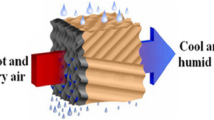Abstract
The exhaust performance of a cooling tower placed in the interior space of a building is crucial due to limited space and stochastic ambient wind conditions. Improper design of the cooling tower could lead to a reduction in thermal efficiency and could also deteriorate the operational performance of the chillers. In this paper, the exhaust performance of cooling towers in a super high-rise building considering both side exhaust and interlayer exhaust methods is investigated using CFD simulations. The results show that the exhaust performance of cooling towers under interlayer exhaust is better than that under side exhaust. However, the exhaust recirculation phenomenon of the cooling towers on the windward side caused by outdoor wind is still obvious because the outdoor wind speed is low. The total pressure differences between the inlet and outlet of the tower units under interlay exhaust become larger with increases in wind speed in each district. The fan total head should be carefully determined to overcome the surplus pressure drop caused by the wind. This study helps to guide other similar cases utilizing the interior space of buildings for the cooling towers.
Similar content being viewed by others
References
Al-Waked R, Behnia M (2006). CFD simulation of wet cooling towers. Applied Thermal Engineering, 26: 382–395.
Al-Waked R, Behnia M (2007). Enhancing performance of cooling tower. Energy Conversion and Management, 48: 2638–2648.
Becker BR, Stewart WE Jr, Walter TM (1989). A numerical model of cooling tower plume recirculation. Mathematical and Computer Modelling, 12: 799–819.
Bhatia A (2001). Cooling Towers. Continuing Education and Development, Inc.
Evapco Bulletin 311G (1999). Equipment Layout Manual. Evapco, Inc.
ECADI (2002). Industrial water treatment. In: Water Supply & Drainage Design Handbook, 2nd edn. Beijing: China Building Industry Press. (in Chinese)
Ge G, Xiao F, Wang S, Pu L (2012). Effects of discharge recirculation in cooling towers on energy efficiency and visible plume potential of chilling plants. Applied Thermal Engineering, 39: 37–44.
Gousseau P, Blocken B, Van Heijst GJF (2012). On validation and solution verification of large-eddy simulation of wind flow around a high-rise building. In: Proceedings of 7th International Colloquium on Bluff Body Aerodynamics and Applications (BBAA7), Shanghai, China.
Gu Z, Chen X, Lubitz W, Li Y, Luo W (2007). Wind tunnel simulation of exhaust recirculation in an air-cooling system at a large power plant. International Journal of Thermal Sciences, 46: 308–317.
Hsieh CM, Aramaki T, Hanaki K (2007). The feedback of heat rejection to air conditioning load during the nighttime in subtropical climate. Energy and Buildings, 39: 1175–1182.
Hsieh CM, Aramaki T, Hanaki K (2011). Managing heat rejected from air conditioning systems to save energy and improve the microclimates of residential buildings. Computers, Environment and Urban Systems, 35: 358–367.
Kaiser AS, Lucas M, Viedma A, Zamora B (2005). Numerical model of evaporative cooling processes in a new type of cooling tower. International Journal of Heat Transfer, 48: 986–999.
Lee JH, Moshfeghi M, Choi YK, Hur N (2014). A numerical simulation on recirculation phenomena of the plume generated by obstacles around a row of cooling towers. Applied Thermal Engineering, 72: 10–19.
Meroneya RN (2006). Protocol for CFD prediction of cooling tower drift in an urban environment. In: Proceedings of 4th International Symposium on Computation Wind Engineering (CWE2006), Yokohama, Japan.
Meteorological Information Center of CMA (2005). Building Thermal Environment Analysis of China Private Meteorological Data Sets. Beijing: China Architecture and Building Press. (in Chinese)
Moon SA, Lee TG, Hur JH, Heo KM, Yoo H, Moon SJ, Lee JH (2008). Study on the reentering rates of individual cooling towers installed on a building roof. Heat and Mass Transfer, 44: 1345–1353.
Patankar SV (1980). Numerical Heat Transfer and Fluid Flow. Washington DC: CRC Press.
MOHURD (Ministry of Housing and Urban-Rural Development of China)(2012). Load Code for the Design of Building Structures. Beijing: China Architecture and Building Press. (in Chinese)
Rahmatmand A, Yaghoubi M, Rad EG, Tavakol MM (2014). 3D experimental and numerical analysis of wind flow around domed-roof buildings with open and closed apertures. Building Simulation, 7: 305–319.
Schatzmann M, Britter R (2011). Quality assurance and improvement of micro-scale meteorological models. International Journal of Environment and Pollution, 44: 139–146.
Sev A, Özgen A (2009). Space efficiency in high-rise office buildings. METU Journal of the Faculty of Architecture, 26(2): 69–89.
Tominaga Y, Mochida A, Yoshie R, Kataoka H, Nozu T, Yoshikawa M, Shirasawa T (2008). AIJ guidelines for practical applications of CFD to pedestrian wind environment around buildings. Journal of Wind Engineering and Industrial Aerodynamics, 96: 1749–1761.
Tominaga Y, Stathopoulos T (2013). CFD simulation of near-field pollutant dispersion in the urban environment: A review of current modeling techniques. Atmospheric Environment, 79: 716–730.
Wang S (2010). Intelligent Buildings and Building Automation. Abingdon, UK: Spon Press.
Williamson N, Armfield S, Behnia M (2008). Numerical simulation of flow in a natural draft wet cooling tower-The effect of radial thermo-fluid fields. Applied Thermal Engineering, 28: 178–189.
Liu X, Niu J, Kwok KCS (2013). Evaluation of RANS turbulence models for simulating wind-induced mean pressures and dispersions around a complex-shaped high-rise building. Building Simulation, 6: 151–164.
Xuan YM, Xiao F, Niu XF, Huang X, Wang SW (2012). Research and application of evaporative cooling in China: A review (I)-Research. Renewable and Sustainable Energy Reviews, 16: 3535–3546.
Yoshie R, Mochida A, Tominaga T, Kataoka H, Yoshikawa M (2005). Cross comparisons of CFD prediction for wind environment at pedestrian level around buildings. Part 1 Comparison of results for flow-field around a high-rise building located in surrounding city blocks. In: Proceedings of 6th Asia-Pacific Conference on Wind Engineering (APCWE-VI), Seoul, Korea.
Zhao WL, Liu PQ (2008). Experimental researches of the effect of environmental wind on thermal recirculation under the tower of direct air cooled system. Journal of Power Engineering, 23(3): 390–394. (in Chinese)
Author information
Authors and Affiliations
Corresponding author
Rights and permissions
About this article
Cite this article
Zhuang, Z., Hsieh, CM. & Wang, B. Evaluation of exhaust performance of cooling towers in a super high-rise building: A case study. Build. Simul. 8, 179–188 (2015). https://doi.org/10.1007/s12273-014-0201-8
Received:
Revised:
Accepted:
Published:
Issue Date:
DOI: https://doi.org/10.1007/s12273-014-0201-8




